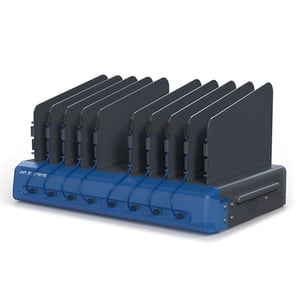Each school year, students return to find that a number of teachers have retired or left for another school. In fact, an average of 16% of public-school teachers switch schools or leave the profession annually, detrimentally affecting numerous elements of learning.
Although it is undeniable that access to technology is important, the true power of it lies in the hands of teachers and how they use it. When properly devised, delivered, and evaluated, digital learning initiatives enhance the curriculum. However, when teachers leave, the benefits associated with digital learning are often disrupted. Continue reading to discover how high teacher turnover rates challenge digital learning opportunities...
Harnessing Technology for Personalized Learning
The opportunity to help every student learn at the best pace and on the best path for them is one of the most important benefits associated with digital learning. By finding different tools according to students’ unique needs, teachers can use technology to tailor the lesson based on the learner’s passions, strengths, and needs. However, a high teacher turnover rate decreases this important benefit of using technology in the classroom.
Personalized learning does not entail providing each student with a Chromebook device. Rather, it relies on the teacher’s ability to form relationships with their students. The relationships are what assist teachers in gauging their students’ interests, which in turn provides useful insight as to which digital tools will help appeal to and engage their students, address learning gaps, and accelerate learning.
For new or substitute teachers given limited time, it is harder to form the meaningful relationships necessary to tailor quality learning opportunities to each student. This highlights the idea that the amount of time a teacher has to get to know their students is an essential factor in harnessing technology for personalized learning.
Driving Deeper Learning Opportunities Digitally The deeper learning framework helps prepare students for the future by providing opportunities to learn essential life skills including how to collaborate, create, solve problems, and communicate with peers. In order for students to learn these skills, teachers must commit to designing lessons that are compelling, challenging, and purposeful—a feat in which digital strategies, such as blended learning, are most useful.
The deeper learning framework helps prepare students for the future by providing opportunities to learn essential life skills including how to collaborate, create, solve problems, and communicate with peers. In order for students to learn these skills, teachers must commit to designing lessons that are compelling, challenging, and purposeful—a feat in which digital strategies, such as blended learning, are most useful.
High levels of teacher turnover, however, can make it difficult to create a digital climate conducive to deeper learning. This means that although current innovations in technology provide a diverse and seemingly endless number of learning opportunities, it is how and whether these tools are used that counts. Unfortunately, teachers who feel like their time and energy in the classroom is undervalued are less likely to spend as much time developing, or improving, the curriculum to use the new digital tools that are available.
In addition, substitute teachers who are brought in midway through the year are already under enough pressure to cover certain standards required by the state, let alone develop additional coursework. For this reason, it is essential to provide teachers with the professional development, support, and encouragement they need to diversify their curriculum and include the digital tools that add greater value and support deeper learning initiatives.
Improving Digital Achievement
According to the Learning Policy Institute, teachers are the number one in-school influence on student achievement. This means that, logically: If the teachers who leave are equally as effective at using technology as their replacements, there should be no negative effect on digital learning. Even so, there is usually an adjustment period within which new teachers struggle to adapt to and implement a curriculum they are not yet familiar with.
This transition can not only hinder digital progress, but also decrease students’ engagement in the content. Moreover, not all new hires will be as effective as their predecessors and likewise, some teachers may have more experience with technology than others. This can increase or decrease the rate at which digital learning tools are integrated into the classroom, disrupting students’ progress and achievement rates. Overall, hiring and retaining effective teachers is critical for students’ digital learning success.
Maintaining Digital Continuity
When a teacher leaves a classroom, the flow of learning is disrupted. Relationships formed between a teacher and their students are severed, and the students’ academic support system is weakened. The classroom climate changes, and so can students’ engagement in the lesson plan. Occasionally it may be for the better, but that’s not always the case!
As you can imagine, it can be a challenge for new teachers to develop a repertoire with students. And although they often have similar goals to their predecessors, it is common for different teachers to use different techniques or digital tools to achieve them. This can impair classroom progress, such as by disrupting learning time to teach students how to use new tools, rather than those they are familiar with.
On top of that, high teacher turnover can result in repetitive lessons, leading students to disengage with the task by feeling that they are “starting over” instead of moving forward. To avoid this effect, schools must work toward providing the continuity necessary for students to build upon previous digital achievements to reach new goals.
Reducing Turnover Rates Helps Support Digital Learning Strategies
Teacher turnover is an important problem not only in its magnitude, but also in its negative effects on digital learning initiatives. This makes it important to understand why teachers leave and what steps can be taken to reduce the current teacher turnover rates. It is with forward-thinking strategies that prioritize recruiting, mentoring, and retaining talented teachers that districts and schools can enhance their digital learning success.
Conveniently Power and Charge Up to 8 USB-C Devices at Once JAR Systems has developed a charging dock capable of charging up to 8 USB-C devices simultaneously. This versatile solution is the first of its kind, and uses sophisticated charging technology that automatically senses and adjusts the power supply to suit the needs of Chromebooks, notebooks, tablets, and other mobile devices. Click below to learn more about the Universal USB-C Charging Dock!
JAR Systems has developed a charging dock capable of charging up to 8 USB-C devices simultaneously. This versatile solution is the first of its kind, and uses sophisticated charging technology that automatically senses and adjusts the power supply to suit the needs of Chromebooks, notebooks, tablets, and other mobile devices. Click below to learn more about the Universal USB-C Charging Dock!

